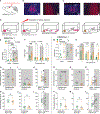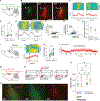A circuit from the locus coeruleus to the anterior cingulate cortex modulates offspring interactions in mice
- PMID: 37421626
- PMCID: PMC10529180
- DOI: 10.1016/j.celrep.2023.112771
A circuit from the locus coeruleus to the anterior cingulate cortex modulates offspring interactions in mice
Abstract
Social sensitivity to other individuals in distress is crucial for survival. The anterior cingulate cortex (ACC) is a structure involved in making behavioral choices and is influenced by observed pain or distress. Nevertheless, our understanding of the neural circuitry underlying this sensitivity is incomplete. Here, we reveal unexpected sex-dependent activation of ACC when parental mice respond to distressed pups by returning them to the nest ("pup retrieval"). We observe sex differences in the interactions between excitatory and inhibitory ACC neurons during parental care, and inactivation of ACC excitatory neurons increased pup neglect. Locus coeruleus (LC) releases noradrenaline in ACC during pup retrieval, and inactivation of the LC-ACC pathway disrupts parental care. We conclude that ACC maintains sex-dependent sensitivity to pup distress under LC modulation. We propose that ACC's involvement in parenting presents an opportunity to identify neural circuits that support sensitivity to the emotional distress of others.
Keywords: CP: Neuroscience; anterior cingulate; chemogenetics; in vivo; locus coeruleus; noradrenaline; parental behavior; prosocial behavior.
Copyright © 2023 The Authors. Published by Elsevier Inc. All rights reserved.
Conflict of interest statement
Declaration of interests P.O. has a financial interest in Certerra, a company that offers whole-brain imaging services.
Figures







Similar articles
-
Ascending noradrenergic excitation from the locus coeruleus to the anterior cingulate cortex.Mol Brain. 2020 Mar 26;13(1):49. doi: 10.1186/s13041-020-00586-5. Mol Brain. 2020. PMID: 32216807 Free PMC article.
-
The Projection-Specific Noradrenergic Modulation of Perseverative Spatial Behavior in Adult Male Rats.eNeuro. 2024 Aug 19;11(8):ENEURO.0063-24.2024. doi: 10.1523/ENEURO.0063-24.2024. Print 2024 Aug. eNeuro. 2024. PMID: 39160074 Free PMC article.
-
Precise and Pervasive Phasic Bursting in Locus Coeruleus during Maternal Behavior in Mice.J Neurosci. 2022 Apr 6;42(14):2986-2999. doi: 10.1523/JNEUROSCI.0938-21.2022. Epub 2022 Mar 10. J Neurosci. 2022. PMID: 35273081 Free PMC article.
-
Pain-induced adaptations in the claustro-cingulate pathway.Cell Rep. 2023 May 30;42(5):112506. doi: 10.1016/j.celrep.2023.112506. Epub 2023 May 13. Cell Rep. 2023. PMID: 37182208 Free PMC article.
-
Adaptive decision making and value in the anterior cingulate cortex.Neuroimage. 2007;36 Suppl 2(Suppl 2):T142-54. doi: 10.1016/j.neuroimage.2007.03.029. Epub 2007 Mar 30. Neuroimage. 2007. PMID: 17499161 Free PMC article. Review.
Cited by
-
Neural circuits regulating visceral pain.Commun Biol. 2024 Apr 13;7(1):457. doi: 10.1038/s42003-024-06148-y. Commun Biol. 2024. PMID: 38615103 Free PMC article. Review.
-
Whole-brain mapping of afferents to the anterior cingulate cortex in adult mice.Mol Pain. 2024 Jan-Dec;20:17448069241300990. doi: 10.1177/17448069241300990. Mol Pain. 2024. PMID: 39614717 Free PMC article.
-
Inhibitory gamma-aminobutyric acidergic neurons in the anterior cingulate cortex participate in the comorbidity of pain and emotion.Neural Regen Res. 2025 Oct 1;20(10):2838-2854. doi: 10.4103/NRR.NRR-D-24-00429. Epub 2024 Sep 24. Neural Regen Res. 2025. PMID: 39314159 Free PMC article.
-
The neurobiology of parenting and infant-evoked aggression.Physiol Rev. 2025 Jan 1;105(1):315-381. doi: 10.1152/physrev.00036.2023. Epub 2024 Aug 15. Physiol Rev. 2025. PMID: 39146250 Free PMC article. Review.
-
Neural basis for behavioral plasticity during the parental life-stage transition in mice.Front Neural Circuits. 2024 Jan 16;17:1340497. doi: 10.3389/fncir.2023.1340497. eCollection 2023. Front Neural Circuits. 2024. PMID: 38298741 Free PMC article. Review.
References
-
- Numan M (2020). The Parental Brain Mechanisms, Development an Evolution (Oxford University Press; ).
Publication types
MeSH terms
Grants and funding
LinkOut - more resources
Full Text Sources
Molecular Biology Databases
Miscellaneous

